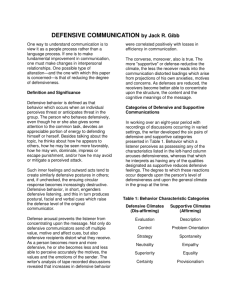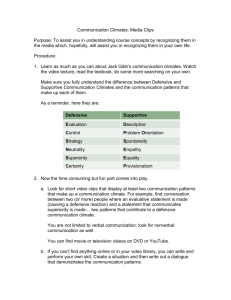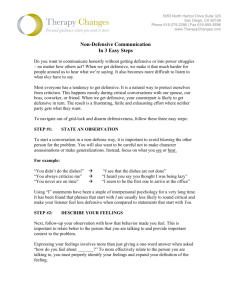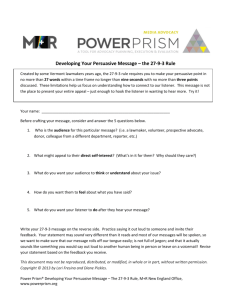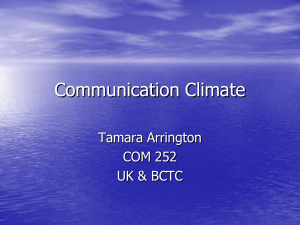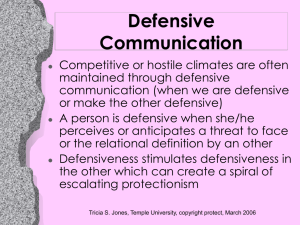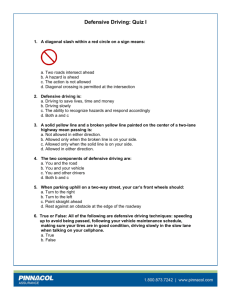Defensive Communication: Understanding & Reducing Defensiveness
advertisement
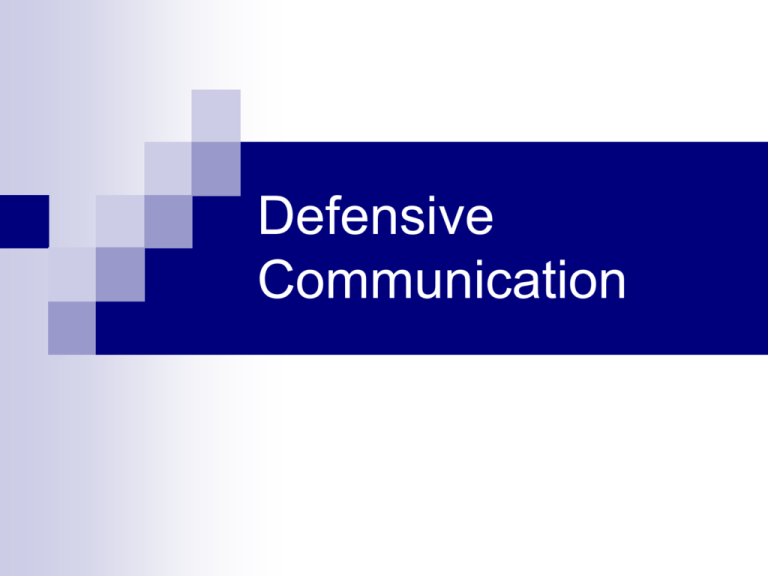
Defensive Communication Definition and Significance Defensive Behavior – That behavior which occurs when an individual perceives threat or anticipates threat in a group. A person who behaves defensively devotes an substantial portion of energy to defending him/herself. In addition to talking about it: they think about how they appears to others how they may be seen more favorably how they may win, dominate, impress or escape punishment how they may avoid or lessen a perceived attack. These inner feelings and outward acts tend to create similarly defensive postures. If unchecked, the circular response becomes increasingly destructive. Defensive behavior defensive listening produce facial and verbal cues which raise the defense level of the original communicator. This defensive behavior prevents the listener from concentrating on the message. Not only do defensive communicators send off these cues, but defensive listeners tend to distort what they receive. As people become more and more defensive, they become less and less able to perceive accurately the motives, values and emotions of the sender. The opposite is also true. The more “supportive” the climate, the less the receiver reads into the message. As defenses are reduced, the receivers become better able to concentrate on the structure, content and meanings of the message. Defensive and Supportive Categories Behavior which a listener perceives as possessing any of the characteristics listed in the left column arouses defensiveness whereas that which they interpret as having any of the qualities designated as supportive reduces defensive feelings. Defensive Climates Supportive Climates Evaluation Description Control Problem Orientation Strategy Spontaneity Neutrality Empathy Superiority Equality Certainty Provisionalism Evaluation and Description Evaluation – Speech or other behavior which appears to be evaluating or judging the listener will put the listener on guard. Could be manner of speech, tone of voice or content of the message. Evaluation and Description For example, after an earth tremor that shook the house, a mother seeks her son saying, “Bobby, where are you?” His chronic mild defensiveness might respond, “Mommy, I didn’t do it.” Why? Because speech is so frequently judgmental. Evaluation and Description Descriptive Speech – Tends to arouse a minimum of un-easiness. Speech which the listener perceives as a genuine request for information. If the listener thought that the speaker regarded him as an equal, was being open and spontaneous. Control and Problem Orientation Control – Speech which is used to control the listener evokes resistance. In most social interactions, someone is trying to do something to someone else. The degree to which attempts to control produce defensiveness, depends on the openness of the effort. The suspicion that a hidden motive exists heightens resistance. Control and Problem Orientation Problem Orientation – Non-controllers must earn the perception that their efforts have no hidden motives. Implicit in all attempts to alter another person is the assumption that the person to be altered is inadequate. That the speaker sees the listener as ignorant, uniformed, immature, unwise, etc. Strategy and Spontaneity Strategy – when a sender is perceived as ambiguous and with multiple motivations, the receiver has a tendency to become defensive. No one wants to be the guinea pig or the victim of some hidden motivation. Strategy and Spontaneity Spontaneity - Voluntary or undetermined action or movement. Behavior that appears to be spontaneous and free of deception is defense reductive. If the communicator is seen as having uncomplicated motivation, straightforward and honest as behaving spontaneously in response to the situation is likely to arouse minimal defensiveness. Neutrality and Empathy Neutrality – When appearing to indicate a lack of concern for his welfare, the listener becomes defensive. Listeners desire to be perceived as valued persons. Neutrality and Empathy Empathy - Identification with and understanding of another's situation, feelings, and motives. Communication that conveys empathy for the feelings and respect for the worth of the listener is supportive and defense reductive. This includes non-verbal, spontaneous expressions that are interpreted as especially valid evidence of empathy. Superiority and Equality Superiority – When a person communicates to another that he or she feels superior in position, power, wealth, intellectual ability, physical characteristics or other ways, they arouse defensiveness. The receiver reacts by not hearing, forgetting, competing with the sender or become jealous. Superiority and Equality Equality – Creating the atmosphere that the sender feels equal to the listener. Defenses are reduced when one perceives the sender as willing to enter in to participative planning with mutual trust and respect. But attaching little importance to these differences reduce defenses. Certainty and Provisionalism Certainty (Dogmatism) - Unfounded positiveness in matters of opinion; arrogant assertion of opinions as truths. Those who seem to know the answers, to require no additional and to regard themselves as teachers rather than as coworkers tend to put others on guard. Certainty and Provisionalism Provisional – Accepted or adopted tentatively; conditional; probationary. When one communicates that one is willing to experiment with one’s own behavior, attitudes and ideas, defensiveness is reduced. The person that appears to be investigating issues rather than taking sides on them, problem solving tends to show there is a shared quest or investigation of the ideas.
